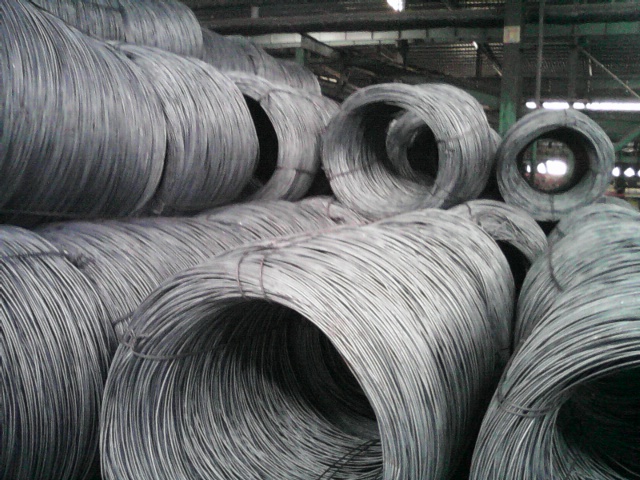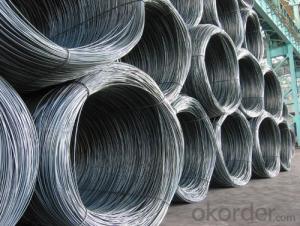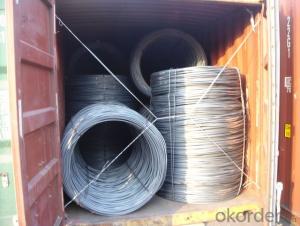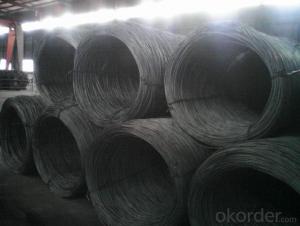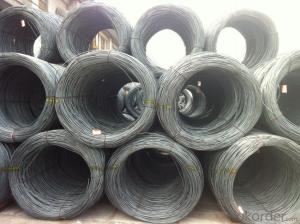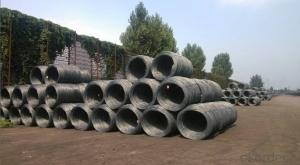Hot Rolled Carbon Steel Wire Rod High Quality
- Loading Port:
- China Main Port
- Payment Terms:
- TT or LC
- Min Order Qty:
- -
- Supply Capability:
- -
OKorder Service Pledge
OKorder Financial Service
You Might Also Like
Product Description:
OKorder is offering Wire Rod at great prices with worldwide shipping. Our supplier is a world-class manufacturer of steel, with our products utilized the world over. OKorder annually supplies products to European, North American and Asian markets. We provide quotations within 24 hours of receiving an inquiry and guarantee competitive prices.
Product Applications:
After hot-rolled the products shaped into coil and delivery as finished product, including round, square, rectangular, hexagonal and so on. Since most of the products are round, it is generally called wire rod. Carbon steel wire rod is widely used in construction and manufacturing. Carbon steel wire rod is mainly used for reinforcement of reinforced concrete and welded structure or reprocessed (roberts , nail, etc.) materials, especially used to produce wire drawing, welding electrode, nails, spring, electronic, precise machinery parts and so on.
.
Product Advantages:
OKorder's Wire Rod are durable, strong, and resist corrosion.
Main Product Features:
· Premium quality
· Prompt delivery & seaworthy packing (30 days after receiving deposit)
· Corrosion resistance
· Can be recycled and reused
· Mill test certification
· Professional Service
· Competitive pricing
Product Specifications:
Steel Grade: Q195/235, SAE1006-1018B Standard: ASTM, GB
Diameter: 5.5mm, 6.5mm, 7mm,8mm,9mm,10mm,12mm,14mm
Type: in coil, coil weight around 2MT Alloy or Not: Alloy
Surface: round, no twisted, light and smooth Chemical Composition: (Please kindly find our chemistry of our material based on Q195、Q235A and Q235B as below for your information)
Trademark | Rank | Chemical composition (quality score) % | |||||
C | Si | Mn | S | P | |||
| ≤ |
| ≤ | ≤ | |||
Q195 |
| 0.06-0.12 | 0.30 | 0.25 | 0.050 | 0.045 | |
Q235 | A | 0.14-0.22 | 0.30 | 0.30-0.65 | 0.050 | 0.045 | |
Q235 | B | 0.12-0.20 | 0.30 | 0.30-0.70 | 0.045 | 0.045 | |
Trademark | Rank | Pulling Test | |||||
Bend PointΔs/Mpa | Tensile Strength | Elongation Ratioδ5% | |||||
Thickness (Diameter) /MM | Thickness (Diameter) /MM | ||||||
≤16 | 16-40 | ≤16 | 16-40 | ||||
≥ | ≥ | ||||||
Q195 |
| 195 | 185 | 315-390 | 33 | 32 | |
Q235 | A | 235 | 225 | 375-500 | 26 | 25 | |
Q235 | B | 235 | 225 | 375-500 | 26 | 25 | |
FAQ:
Q1: Why buy Materials & Equipment from OKorder.com?
A1: All products offered byOKorder.com are carefully selected from China's most reliable manufacturing enterprises. Through its ISO certifications, OKorder.com adheres to the highest standards and a commitment to supply chain safety and customer satisfaction.
Q2: How do we guarantee the quality of our products?
A2: We have established an advanced quality management system which conducts strict quality tests at every step, from raw materials to the final product. At the same time, we provide extensive follow-up service assurances as required.
Q3: What makes stainless steel stainless?
A3: Stainless steel must contain at least 10.5 % chromium. It is this element that reacts with the oxygen in the air to form a complex chrome-oxide surface layer that is invisible but strong enough to prevent further oxygen from "staining" (rusting) the surface. Higher levels of chromium and the addition of other alloying elements such as nickel and molybdenum enhance this surface layer and improve the corrosion resistance of the stainless material.
Images:
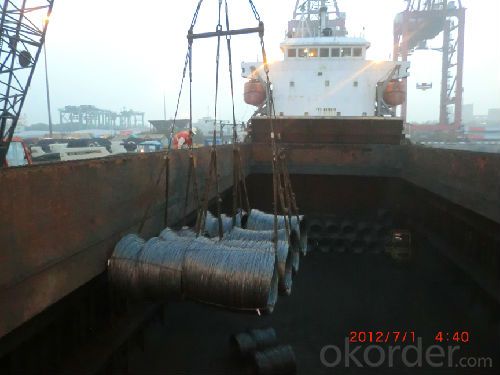
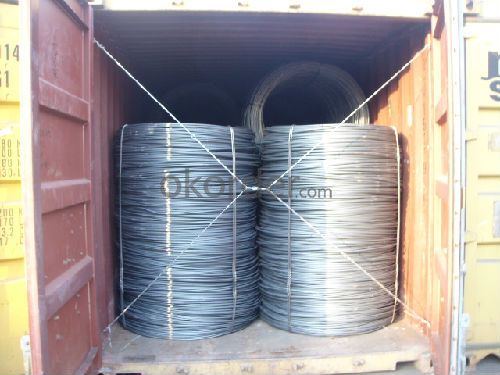
- Q: How does the magnetic properties of steel wire rod vary with different grades?
- The magnetic properties of steel wire rod can vary significantly with different grades. The magnetic behavior of steel is primarily determined by its composition and microstructure, which can be altered in various ways to achieve different grades of steel. In general, steel wire rods with a higher carbon content tend to have lower magnetic properties. This is because carbon atoms disrupt the alignment of magnetic domains within the steel, reducing its overall magnetic strength. Therefore, low carbon steel grades, such as AISI 1006 or SAE J403 Grade 1006, typically exhibit weaker magnetic properties. On the other hand, steel wire rods with higher alloying elements, such as chromium, nickel, or manganese, tend to have increased magnetic strength. These alloying elements can influence the microstructure of the steel, promoting the formation of magnetic domains and enhancing the overall magnetization. Stainless steel grades, which contain a significant amount of chromium and nickel, often exhibit stronger magnetic properties compared to low carbon steel grades. It is important to note that while certain steel grades may have inherently stronger or weaker magnetic properties, the specific processing and heat treatment techniques applied during the manufacturing of wire rods can also influence the magnetic behavior. Different heat treatments can alter the microstructure and precipitate various phases within the steel, thereby affecting its magnetic properties. In summary, the magnetic properties of steel wire rod vary with different grades due to differences in composition, alloying elements, and microstructure. Steel grades with higher carbon content generally exhibit weaker magnetic properties, while those with higher alloying elements tend to have increased magnetization. Additionally, the specific processing and heat treatment techniques used during manufacturing can also impact the magnetic behavior of steel wire rod.
- Q: What are the different types of steel wire rod finishes for improved solderability?
- There are several types of steel wire rod finishes that can be used to improve solderability. These include copper-coated finishes, zinc-coated finishes, and nickel-coated finishes. Copper-coated finishes provide excellent solderability due to the ability of copper to form a strong bond with solder. Zinc-coated finishes create a protective layer on the surface of the wire rod, preventing oxidation and enhancing solderability. Nickel-coated finishes offer improved solderability through their ability to bond well with solder and provide a smooth surface for soldering. These different finishes allow for increased solderability depending on the specific requirements of the application.
- Q: What are the different types of steel wire rod surface defects after wire drawing?
- There are several different types of steel wire rod surface defects that can occur after wire drawing. Some common examples include scratches, pits, scale, cracks, and uneven surfaces. These defects can affect the quality and performance of the wire, so it is important to identify and address them in order to ensure the desired product quality.
- Q: What are the common safety guidelines for steel wire rod usage?
- Some common safety guidelines for steel wire rod usage include wearing appropriate personal protective equipment such as gloves, safety glasses, and steel-toed shoes. It is important to handle and store the wire rods properly to prevent injuries, such as avoiding sharp edges and ensuring that they are stacked securely. Regular maintenance and inspection of equipment and tools used with steel wire rods should also be conducted to ensure their safe operation. Additionally, proper training and awareness of potential hazards associated with handling steel wire rods are crucial for maintaining a safe working environment.
- Q: How is steel wire rod used in the production of wire mesh conveyor belts?
- Wire mesh conveyor belts rely on steel wire rod as a vital ingredient for their production. Industries such as food processing, mining, and automotive manufacturing commonly utilize these belts. The steel wire rod undergoes a series of machine processes to achieve the desired thickness and strength of the wires. Once formed, the wires are interwoven to create a mesh pattern. The steel wire rod provides the necessary durability and strength to withstand the demanding conditions encountered in conveyor belt applications, including heavy loads and high temperatures. Additionally, the flexibility of the steel wire rod allows for easy bending and shaping of the mesh to fit different conveyor belt configurations. Wire mesh conveyor belts offer numerous advantages compared to traditional belts made from alternative materials. Their open mesh design promotes better airflow and drainage, making them ideal for situations involving heat or liquids. They also possess an excellent strength-to-weight ratio, ensuring long-lasting performance and reducing maintenance expenses. Furthermore, the steel wire rod used in wire mesh conveyor belts can be coated with materials like PVC or galvanized to enhance its resistance to corrosion. This further extends the lifespan of the conveyor belt, making it suitable for deployment in harsh environments or industries with corrosive substances. In conclusion, steel wire rod plays a critical role in the production of wire mesh conveyor belts. Its strength, durability, and flexibility make it well-suited for enduring heavy loads, high temperatures, and corrosive environments. These belts offer several advantages over traditional conveyor belts, which has contributed to their popularity across various industries.
- Q: What are the common industry standards for steel wire rod manufacturers?
- The common industry standards for steel wire rod manufacturers typically include specifications related to the chemical composition, mechanical properties, dimensional accuracy, surface quality, and packaging requirements of the wire rods. These standards are set by organizations such as the American Society for Testing and Materials (ASTM), International Organization for Standardization (ISO), and national or regional standards bodies. Compliance with these standards ensures the quality and consistency of steel wire rod products in the market.
- Q: How are steel wire rods used in the manufacturing of cables?
- Steel wire rods are an essential component in the manufacturing of cables. These rods serve as the core material for cable production and provide the necessary strength and durability required for various applications. To begin the cable manufacturing process, steel wire rods are carefully selected based on their quality and specific properties such as tensile strength, ductility, and corrosion resistance. These characteristics ensure that the final product will meet the desired standards and perform effectively in its intended application. Once the appropriate steel wire rods are chosen, they are subjected to various manufacturing processes such as drawing and stranding. Firstly, the rods are drawn through a series of dies to reduce their diameter and increase their length. This process, known as wire drawing, enhances the tensile strength and flexibility of the steel wire, ensuring it can withstand the stresses and strains that cables may encounter during their usage. Next, the drawn steel wires are stranded together to form the cable. Stranding involves intertwining multiple steel wires into a compact and uniform arrangement, creating a strong and flexible structure. The number of wires and their arrangement in the stranding process depend on the specific cable design and application requirements. Additionally, steel wire rods are often coated or treated with protective materials to enhance their performance. These coatings may include galvanization to prevent corrosion, lubricants to improve flexibility, or insulation materials to provide electrical insulation properties. These treatments further enhance the durability, longevity, and functionality of the cables. Overall, steel wire rods play a critical role in the manufacturing of cables by providing the necessary strength, flexibility, and durability required for reliable and efficient transmission of various signals, power, or data.
- Q: How is steel wire rod used in the manufacturing of nails and screws?
- Steel wire rod is used in the manufacturing of nails and screws as it serves as the primary raw material. It is first drawn through a series of dies to reduce its diameter to the desired size and shape. This process not only strengthens the wire but also increases its tensile strength. The resulting steel wire is then cut into appropriate lengths and shaped into nails or screws using specialized machinery. The high-quality and durable nature of steel wire rod make it an ideal material for producing nails and screws with excellent strength and corrosion resistance.
- Q: What are the common applications of pre-stressed and oil tempered steel wire rod?
- Pre-stressed steel wire rod is commonly used in construction and engineering applications, such as for pre-tensioning or post-tensioning of concrete structures, bridges, and high-rise buildings. It helps to improve the load-bearing capacity, durability, and overall structural integrity of these projects. On the other hand, oil tempered steel wire rod is frequently utilized in the manufacturing of springs, suspension systems, and other high-stress applications. Its unique properties, obtained through the tempering process, provide excellent resistance to fatigue and ensure reliable performance in demanding industries such as automotive, aerospace, and machinery.
- Q: How is the formability of steel wire rod assessed?
- The formability of steel wire rod is typically assessed through various mechanical tests and evaluations. One of the commonly used methods is the tensile test, where a sample of the wire rod is pulled until it breaks. This test helps determine the maximum load the wire rod can withstand before failure, providing insights into its strength and ductility. Another method used to assess formability is the bend test, where the wire rod is bent to a specified angle without cracks or fractures. This test evaluates the wire rod's ability to withstand deformation without failure or the development of defects. Additionally, the deep drawing test is employed to gauge the wire rod's ability to be stretched and formed into complex shapes without fracturing or tearing. This test is particularly relevant for wire rod used in manufacturing processes such as automotive components or household appliances. Other assessments may include hardness testing, which measures the wire rod's resistance to indentation or penetration, and impact testing, which evaluates its ability to absorb energy under sudden loading conditions. By conducting these tests and evaluations, manufacturers and researchers can determine the formability of steel wire rod and ensure it meets the required standards and specifications for specific applications.
Send your message to us
Hot Rolled Carbon Steel Wire Rod High Quality
- Loading Port:
- China Main Port
- Payment Terms:
- TT or LC
- Min Order Qty:
- -
- Supply Capability:
- -
OKorder Service Pledge
OKorder Financial Service
Similar products
Hot products
Hot Searches
Related keywords



